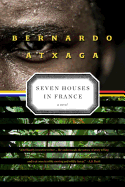« Back
Publishers Weekly presenta un adelanto de la publicación de "Seven houses in France" en los EEUU
2012-09-07 ¦ Publicaciones
La novela "Seven Houses in France" ("Siete casas en Francia") verá la luz en septiembre en los Estados Unidos. La revista Publishers Review se ha adelantado a la publicación y ya ha presentado el último trabajo de Atxaga a sus lectores.

La revista americana Publishers Review acaba de publicar una muy positiva referencia sobre la última novela de Bernardo Atxaga, Seven Houses in France.
La edición americana verá la luz el próximo mes de septiembre, tras publicarse el pasado año en el Reino Unido, pero Publishers Weekly ya se ha adelantado en su último número :
Atxaga has been compared to Conrad, but the writer’s captivating literary anthropologies don’t seek to edify or shed light on the human condition. In his new, shamefully enjoyable novel, set in the Belgian Congo in the early part of the last century, the arrival of a devout and taciturn young officer into a contingent of colorful colonial soldiers on a remote jungle outpost on the River Congo sets off a palpitating chain of events. Chrysostome Liège is the best marksman in the Congo, a fact that his commander, the highfalutin poet-officer Capt. Lalande Biran, decides to use to his advantage—first using Liège to restore order in the bush, and then for more personal reasons. Captain Biran’s beautiful wife wishes to acquire a seventh property in France, in fashionable St-Jean-Cap-Ferrat, “one of the most expensive places in the civilized world,” forcing him to engage in a risky contraband scheme with his covetous subordinate, the psychotic Lieutenant Van Thiegel. Atxaga possesses an uncanny gift for details bordering on the forensic, and he breathes life into this bevy of invariably perfectly pitched characters—from Captain Biran’s cowardly orderly Donatien to the mysterious Club Royal bartender Livo, who finally decides to take matters into his own hands when Van Thiegel perpetuates one final, inexcusable outrage. Nearly impossible to put down, Atxaga’s thrilling colonial masterpiece pulses with a kind of elemental power, like the Congo River itself.
